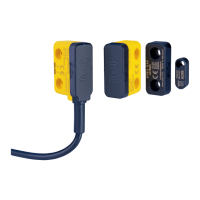3 Product description
3.1 Setup and function
The safety switch consists of two components:
•
S
ensor
The sensor is mounted on the fixed part of the protective device.
•
A
ctuator (transponder)
The actuator is mounted on the moving part of the protective device.
When the guard is closed, the actuator is moved towards the sensor. The sensor
detects the code of the actuator when it reaches the switch-on distance. If the sensor
detects a taught-in code (valid actuator), the sensor sets the OSSD 1 and OSSD 2
safety outputs (semiconductor outlets) to HIGH.
When the protective device is opened, the actuator is moved out of the sensor’s
response range. The sensor sets the OSSD 1 and OSSD 2 safety outputs to Low.
3.2 Product characteristics
3.2.1 Product variants
Overview
T
he safety switch is delivered in different variants. You will find an overview of impor‐
tant distinguishing features of the variants in the following.
•
Universally coded, unique coded, and permanently coded safety switches
•
Actuator version, “Standard”, “Compact”, “Flat” or “Mini”
•
Connection type: Open cable end (5-wire, 7-wire, 3 m, 10 m), cable with male con‐
nector, M12, (5-pin or 8-pin) or M8, 8-pin.
You can find a complete overview of variants on the SICK homepage: www.sick.com/
STR1
Coding
•
Uni
versally coded
All actuators are accepted. No teach-in is required.
•
Uniq
ue coded
An actuator must be taught in during commissioning. Up to 8 actuators may be
t
aught in one after the other. Only the most recently taught-in actuator is valid. Pre‐
viously taught-in actuators can no longer be used.
•
P
ermanently coded
An actuator must be taught in during commissioning. Teach-in only needs to be
per
formed once. It is not possible to teach in any further actuators.
3.2.2 Active sensor surfaces
The sensor has 3 active sensor surfaces:
•
F
ront: black surface
•
2 x sides: yellow surface with long black edge
3.2.3 Fault detection
Any faults that occur, including internal device faults, are detected at the latest with the
ne
xt request (as soon as a safety output switches to HIGH). The safety switch then
switches to safe state. If a fault is detected, the safety circuit is switched off and the
STATE and DIAG LEDs show the error (see table 16).
PRODUCT DESCRIPTION 3
8018754/12IU/2020-01-30 | SICK O P E R A T I N G I N S T R U C T I O N S | STR1
9
Subject to change without notice

